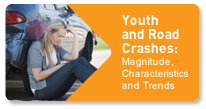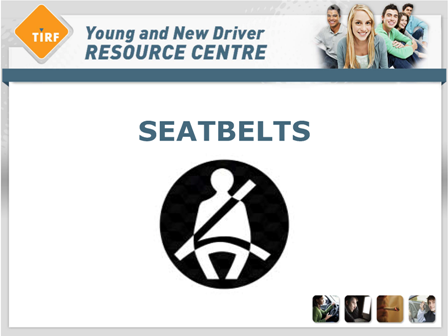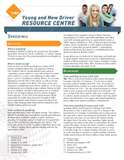The Issues - Belt Use
WHAT ARE... BEHAVIOURS How many Canadians wear seatbelts? ATTITUDES, CONCERNS AND PERCEPTIONS Are Canadians concerned about seatbelts?What do young drivers think about seatbelts? What are the myths about seatbelts? LEGISLATION SOLUTIONS What can parents do to encourage seatbelt use from a young age? WHAT ARE... What are seatbelts? Seatbelts decrease the risk of injury or death in a crash by reducing the movement of occupants inside the vehicle. For instance, if the vehicle is struck and an occupant is not wearing a seatbelt, their body becomes a projectile that can hit anything else inside the vehicle, such as the steering wheel, dashboard or other passengers. With the belt on, the body can minimize its contact with other objects in the vehicle that are moving toward the point of impact. Belts also prevent occupants from being thrown out of the vehicle, through the windshield or doors, where they could hit a pole, tree or rock, or be struck by another vehicle.3 Three-quarters of occupants ejected from a vehicle will die.4 The National Highway Traffic Safety Administration (NHTSA) considers seatbelts to be the single most important protective mechanism available to adult vehicle occupants5 and found that they reduce risk of serious injury to the head, chest and extremities by 50%- 83%.6 1 Sefcik 2012 BEHAVIOURS How many Canadians wear seatbelts? Seatbelt use in Canada increased from 93% in 2007 to 95% in 2010.7 This increase is promising and meets the target that was jointly set by federal, provincial and territorial Ministers of Transport a number of years ago. Although this is a high rate of seatbelt use, increasing seatbelt usage to 100%, if possible, would save a significant number of lives. In 2007 the 7% of Canadians that did not wear seatbelts accounted for almost 40% of collision fatalities, illustrating the importance of seatbelts in preventing deaths. Seatbelts save a thousand lives a year in Canada.8 Who is least likely to wear seatbelts? Young males and drivers aged 18-24 are the least likely groups of drivers to wear seatbelts. The older the age of the driver, the more likely they will wear their seatbelt. The driver’s area of residence also affects seatbelt use. Those who live in urban areas are more likely to wear seatbelts than those in rural areas. This means that as population increases, the rate of seatbelt use increases.9 The rate of seatbelt use in Canada is lowest among occupants of pickup trucks (92%).10 Drivers who are already considered ‘risky’, such as drivers who follow too close to other vehicles, run red lights or speed, are less likely to buckle up, and even more likely to be involved in crashes. These drivers are also more likely to have previous traffic violations. Drivers who have consumed alcohol are more likely to drive without buckling up.11 This is important because many fatal crashes involve alcohol (more than 30%), and by driving without a seatbelt, drunk drivers are putting themselves in even more danger behind the wheel. What is the prevalence of belt use among crash victims? When are young drivers less likely to buckle up? Studies show that when young drivers are driving late at night, with passengers that have high blood alcohol content and with passengers under the age of 29, seatbelt use is much lower than when young drivers are driving alone.15 Thus, a decline in seatbelt use occurs in some situations involving young drivers who have the highest risk of crashing. It is already known that young drivers increase their risk of crashing when driving at night and/or with young passengers. Failing to wear a seatbelt in these situations make young drivers even more vulnerable to death or injury in a crash. How often do young passengers wear seatbelts? The use of seatbelts among young passengers is even lower than the use of seatbelts among young drivers. The rate of passenger belt use decreases among teens as the number of young passengers in the vehicle increases. This is especially the case for passengers in the back seat of the vehicle.16 For instance, in Canada, the rate of seatbelt use is much lower among back seat occupants (89.2%) than among front seat occupants (95.5%).17 Drivers who are wearing their seatbelt are five times more likely to die in a crash if their back seat passengers are not wearing their seatbelt. Injuries to the driver and front seat passenger are caused when the people in the back who are not buckled up catapult to the front. If backseat passengers increased their seatbelt use, up to 80% of the deaths caused by these kinds of crashes would be eliminated.18 7 Transport Canada 2010 ATTITUDES, CONCERNS AND PERCEPTIONS Are Canadians concerned about seatbelts? When respondents of the 2008 Road Safety Monitor (RSM) released by the Traffic Injury Research Foundation (TIRF) were asked what driving behaviours most concerned them, not using a seatbelt ranked third last on the list. Only 66.1% of respondents considered this driving behaviour to be very or extremely risky. Drunk driving ranked first with 95% of respondents considering this an extremely risky driving behaviour.19 This means that Canadians are only moderately concerned with seatbelt use and do not consider it as dangerous as drunk driving, although lack of seatbelt use plays an important role in many deaths caused by speeding, drunk driving, and other dangerous road behaviours. What do young drivers think about seatbelts? In a focus group conducted in the United States, young drivers were asked about seatbelts. None of the teens thought that driving without a seatbelt was a hazardous behaviour. Drivers were more likely to wear seatbelts in the front of the vehicle than the back. When asked why they did or did not wear seatbelts, many wore them only because it was something their parents had insisted upon, and it became habit. Some respondents only buckled up if they saw a police car and others buckled up to avoid hefty fines. Some respondents buckled up when the weather was bad or when they were in a vehicle with a driver who was known as a ‘bad’ or ‘dangerous’ driver.20 What are the myths about seatbelts?
19 Vanlaar et al. 2009 LEGISLATION Are there provincial laws about seatbelts? Yes. All provincial Highway Traffic Acts have laws regarding the proper use of seatbelts in vehicles. For example, all seatbelts in the vehicle must be working and worn by all passengers present. If passengers are under age 16 it is the responsibility of the driver to ensure they have a functioning seatbelt and are wearing it properly. Fines for not wearing a seatbelt range from $75 to $280 depending on the jurisdiction. Ontario drivers, for instance, would receive a $110 ticket if caught without their belt on. Demerit points are also given for seatbelt infractions. Drivers in Saskatchewan accumulate three demerit points when driving without their seatbelts whereas drivers in Alberta receive no demerit points for the infraction, unless they are still in the graduated licencing program, in which case they would receive two points.24 SOLUTIONS What can parents do to encourage seatbelt use from a young age? Parents can set a good example by wearing their own seatbelts as well as buckling up any children in the vehicle. Drivers who do use seatbelts are more likely to buckle up their children. This is a crucial time to begin teaching the importance of seatbelts to young passengers – risky behaviours developed in childhood continue in adolescence and adulthood. Thus, if children are buckled up as soon as they are no longer using a car seat, the behaviour will become a habit and they will be much more likely to buckle up when they are older and no longer under parental supervision.25 What is the proper way to wear a seatbelt? In order for seatbelts to reduce the risk of death or injury in a collision up to 60%, they need to be worn properly. If worn properly, seatbelts spread the force of a collision over the stronger areas of the human skeleton. Follow these guidelines to ensure a seatbelt is worn properly:
What programs and initiatives exist to encourage seatbelt use? There have been several efforts by the government, non-profit organizations and police forces to encourage drivers to buckle up. Fortunately, these initiatives have strongly encouraged usage, but young drivers are still the least likely age group to wear their seatbelts, and this needs to change. Devices such as the ‘rollover simulator’ have been developed to show young drivers the significant difference between a crash while wearing a seatbelt and a crash without wearing a seatbelt. The rollover simulator is a cab of a vehicle with a motor mounted on its top. The motor rolls the cab, simulating a rollover incident, and straw-filled dummies are used to show the effectiveness of seatbelts with them being belted and later unbelted. The goal of the rollover simulator is to help save lives by showing people that seatbelts are the best protection in most types of single vehicle crashes. Saskatchewan Government Insurance has partnered with the RCMP to take this simulator on the road to rural high schools, First Nations communities, trade fairs, malls, and other community events as part of its traffic safety education program. For more information please visit: The most successful seatbelt enforcement campaign ever in the United States was the “Click it or Ticket” program developed by the NHTSA. This program was aimed at young drivers, especially males, and encouraged seatbelt use by raising awareness about the fines for the infraction. Television commercials, posters, and other public advertisements made the program a success and seatbelt use by 16-24 year olds increased from 61% in 1996 to 82% by 2003. Jurisdictions that adopt this comprehensive approach can achieve usage rates of 95%. This program illustrates the importance of the role that law enforcement and fines play in influencing the behaviours of the young driving population. For more information please visit: www.nhtsa.gov/CIOT 25 Durbin et al. 2007 Canadian Council of Motor Transport Administrators (CCMTA). (2010). National Occupant Restraint Program 2010: Annual Monitoring Report 2009. CCMTA Road Safety Report Series. Retrieved from: http://www.ccmta.ca/english/committees/rsrp/norp /pdf/norp_report09.pdf. Durbin, D.R., Smith, R., Kallan, M.J., Elliott, M.R., Winston, F.K. (2007) Seat belt use among 13-15 year olds in primary and secondary enforcement law states. Accident Analysis and Prevention. 39(3), 524-529. European Conference of Ministers of Transport (ECMT). (2006). Young Drivers: The Road to Safety. Organisation for Economic Co-operation and Development. Paris, France. Insurance Corporation of British Columbia (ICBC). (2006). Seatbelts. Road Safety. Injury Research. Retrieved from: http://www.injuryresearch.bc.ca/admin/DocUplo ad/3_200 80424_152043Road_Safety_Seatbelts_TS274S.pdf. National Highway Traffic Safety Administration (NHTSA). (September 2006). Teen Unsafe Driving Behaviours: Focus Group Final Report. DOT HS 810 670. U.S Department of Transportation. Washington, DC. Preusser, D.P., Williams, A.F., Lund, A.K. (1991). Characteristic of Belted and Unbelted Drivers. Accident Analysis and Prevention.23(6), 475-482. Sefcik, L. (2012). Seat Belt Law History. eHow. Retrieved from: http://www.ehow.com /facts_5008257_seat-belt-law-history.html Strine, T.W., Beck, L.F., Bolen, J., Okoro, C., Dhingra, S., Balluz, L. (2010). Geographic and sociodemographic variation in self-reported seat-belt use in the United States. Accident Analysis and Prevention. 42(4), 1067-1071. The Children’s Hospital of Philadelphia. (2013). Miles to go: Focusing on risks for teen drivers. National Teen Driver Safety Report. Transport Canada. (2007). Seat Belt Sense. Road Safety and Motor Vehicle Regulation. TP 14646E. Transport Canada. (2010). Canadian Motor Vehicle Traffic Collision Statistics: 2010. Retrieved from: http://www.tc.gc.ca/eng/roadsafety/tp-1317.htm#11. Transport Canada. (2010). Results of Transport Canada’s Rural and Urban Surveys of Seat Belt Use in Canada 2009-2010. Fact Sheet. Road Safety and Motor Vehicle Regulation Directorate. TP 2436E. Vanlaar, W., Marcoux, K., Robertson, R. (2009). The Road Safety Monitor 2008: Pedestrians and Bicyclists. Traffic Injury Research Foundation. Ottawa, Canada. Williams, A.F., Shabanova, V.I. (2002). Situational Factors in Seat Belt Use by Teenage Drivers and Passengers. Traffic Injury Prevention. 3(3), 201-204. World Health Organization (WHO). (2009). Seat-belts and child restraints: A road safety manual for decisions-makers and practitioners. FIA Foundation for the Automobile and Society. London, United Kingdom. Last updated February 2014 |
  |



